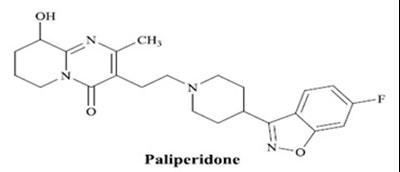Product Images Paliperidone
View Photos of Packaging, Labels & Appearance
Product Label Images
The following 18 images provide visual information about the product associated with Paliperidone NDC 31722-320 by Camber Pharmaceuticals, Inc, such as packaging, labeling, and the appearance of the drug itself. This resource could be helpful for medical professionals, pharmacists, and patients seeking to verify medication information and ensure they have the correct product.
1.5 mg-30s - 1.5 mg 30s
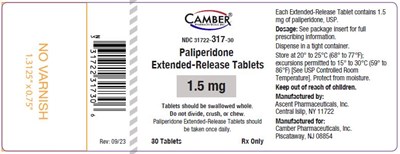
This text provides details about Paliperidone Extended-Release Tablets in 1.5mg dosage. The tablets are intended to be swallowed whole and should not be divided, crushed, or chewed. It includes information on dosage, storage instructions, and manufacturer details. The tablets should be dispensed in a tight container and stored at 20° to 25°C (66° to 77°F) with excursions permitted to 15° to 30°C (59° to 86°F). It emphasizes protecting the tablets from moisture and keeping them out of the reach of children. The medication is manufactured by Ascent Pharmaceuticals, Inc. for Camber Pharmaceuticals, Inc.*
3 mg-30s - 3 mg 30s
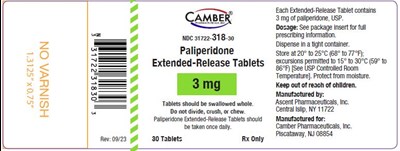
This text provides information about Paliperidone Extended-Release Tablets in 3mg dosage. It includes instructions to swallow the tablets whole and not to divide, crush, or chew them. The tablets should be taken once daily. The text also mentions that each tablet contains 3mg of Paliperidone, USP. It advises to refer to the package insert for dosage details. The tablets should be dispensed in a tight container and stored at 20° to 25°C, with excursions permitted to 15° to 30°C. The manufacturer is noted as Ascent Pharmaceuticals, Inc., located in Central Islip, NY, while the tablets are manufactured for Camber Pharmaceuticals, Inc., based in Piscataway, NJ.*
6 mg-30s - 6 mg 30s
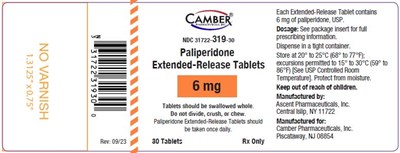
This is a pharmaceutical label for Paliperidone Extended-Release Tablets which should be swallowed whole and not divided, crushed, or chewed. Each tablet contains 6 mg of Paliperidone, USP. The tablets should be taken once daily and stored at 20-25°C (68-77°F), with excursions permitted to 15-30°C (59-86°F) to protect from moisture. The medication should be kept out of reach of children and dispensed in a tight container. For full prescribing information, refer to the package insert.*
9 mg-30s - 9 mg 30s
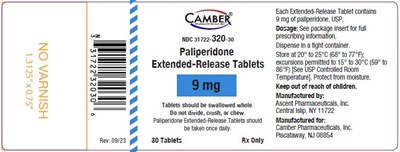
This is a prescription medicine for Paliperidone Extended-Release Tablets containing 9 mg of paiperidone. The tablets should be swallowed whole without dividing, crushing, or chewing and should be taken once daily. The dosage details can be found in the package insert or full prescribing information. The tablets should be stored in a tight container at 20° to 25°C (68° to 77°F) with excursions permitted to 15° to 30°C (59° to 86°F). It is essential to protect them from moisture and keep them out of reach of children. The medication is manufactured by Ascent Pharmaceuticals, Inc., in Centralslp, NY 11722, and is manufactured for Camber Pharmaceuticals, Inc., in Piscataway, NJ 08854.*
10 - Table10
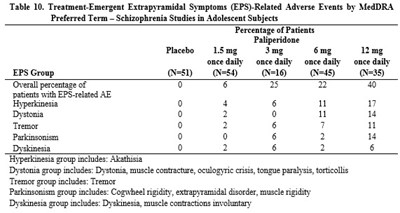
This text provides a breakdown of treatment-emergent extrapyramidal symptoms (EPS)-related adverse events in adolescent subjects with schizophrenia who were part of various medication studies. The table lists the percentages of patients experiencing different types of EPS-related adverse events when taking different doses of Paliperidone compared to a placebo. Specific EPS-related adverse events mentioned include hyperkinesia, dystonia, tremor, Parkinsonism, and dyskinesia. Additionally, it outlines the various subcategories within each group.*
1a - Table1a

This is a description of the change in fasting glucose levels measured in a study involving adult subjects with schizophrenia, focusing on paliperidone use at different doses compared to a placebo. The data includes the mean change from baseline in serum glucose levels and the proportion of patients experiencing shifts from normal to high glucose levels. The text provides information on the number of patients in each treatment group and the corresponding changes in glucose levels from the baseline measurement.*
1 - Table1b

This is a table displaying the change in fasting glucose levels in adolescent subjects with schizophrenia from a placebo-controlled 6-week study. The study evaluated the effect of different doses of Paliperidone on serum glucose levels. The table shows the mean change from baseline in mg/dL for each dose of Paliperidone and the placebo group. Additionally, it presents the proportion of patients with shifts from normal to high glucose levels for each treatment group.*
2a - Table2a
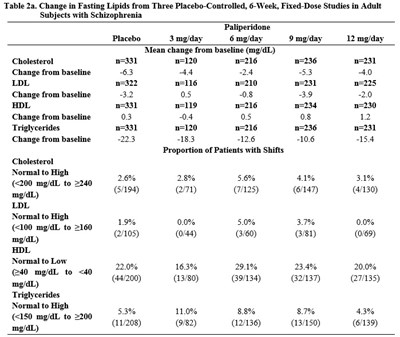
This is a description of changes in fasting lipids from placebo-controlled, fixed-dose studies in adult subjects with schizophrenia. The study evaluated Paliperidone at different doses (3 mg/day, 6 mg/day, 9 mg/day, and 12 mg/day) and measured the mean change from baseline in cholesterol, LDL, HDL, and triglycerides levels. The text also includes data on the proportion of patients with shifts in their lipid levels from normal to high ranges for each type of lipid.*
2 - Table2b
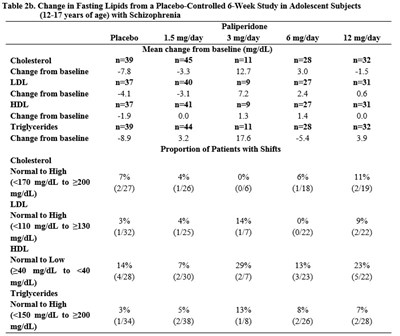
This is a table displaying the change in fasting lipids in adolescent subjects (12-17 years old) with schizophrenia from a placebo-controlled 6-week study. The data includes the mean change from baseline (in mg/dL) for cholesterol, LDL, HDL, and triglycerides under different dosages of Paliperidone. It also shows the proportion of patients with shifts in lipid levels from normal to high or low categories for each lipid type.*
3a - Table3a

This text provides data on the mean change in body weight (in kilograms) and the proportion of subjects with at least a 7% weight gain from three placebo-controlled, 6-week, fixed-dose studies in adult subjects with schizophrenia. The study compares the effects of Paliperidone at varying doses (0mg/day, 1mg/day, 2mg/day, 3mg/day) to a placebo. The number of subjects for each dose is also provided.*
3 - Table3b

This text provides information on the mean change in body weight (kg) and the proportion of subjects with a 7% gain in body weight from a placebo-controlled 6-week study in adolescent subjects (12-17 years of age) with schizophrenia. The study compares the effects of different dosages of Paliperidone (1mg/day, 3mg/day, 6mg/day, and 12mg/day) against a placebo. The results show the baseline weight, change in weight, and the percentage of subjects experiencing a 7% increase in weight.*
4 - Table4
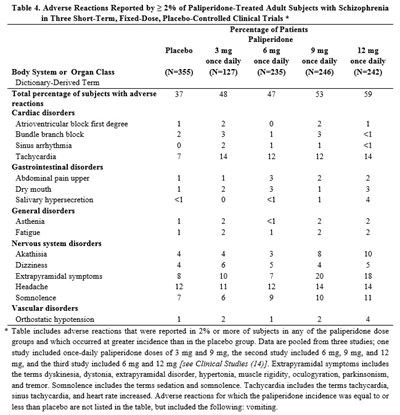
This is a detailed table showing the adverse reactions reported by adult subjects with schizophrenia who were treated with different doses of Paliperidone in clinical trials. The percentages of patients experiencing each adverse reaction are provided, including symptoms related to cardiac disorders, gastrointestinal disorders, general disorders, nervous system disorders, and vascular disorders. The table specifies the percentage of subjects with adverse reactions for each Paliperidone dose group compared to the placebo group. Additionally, it includes a note about the adverse reactions included and excluded in the table based on incidence rates.*
5 - Table5
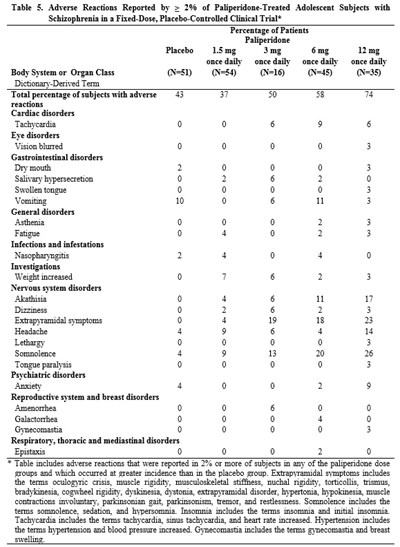
This is a report detailing the adverse reactions reported in a fixed-dose, placebo-controlled clinical trial involving adolescent subjects treated with Paliperidone for schizophrenia. The table outlines the percentage of patients experiencing various adverse reactions such as tachycardia, blurred vision, dry mouth, vomiting, fatigue, increased weight, and psychiatric disorders like anxiety. Extrapyramidal symptoms and somnolence are also noted, along with their respective components. Gynecomastia and respiratory issues like epistaxis are reported as well. The information is crucial for understanding the potential side effects of Paliperidone treatment in this specific population.*
6 - Table6

This is a detailed table listing Adverse Drug Reactions reported by more than 2% of adult subjects with Schizoaffective Disorder who were treated with Paliperidone. The reactions are divided into categories such as Cardiac disorders, Gastrointestinal disorders, General disorders, Infections and Infestations, Nervous system disorders, and more. The data is collected from two double-blind, placebo-controlled clinical trials involving different dosing regimens of Paliperidone. Adverse reactions reported include tachycardia, gastrointestinal discomfort, constipation, dyspepsia, asthenia, myalgia, sleep disorders, and more. The table also provides percentage values for each adverse reaction reported.*
7 - Table7
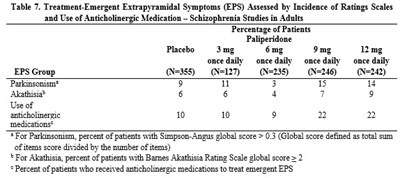
This text provides a table showing the treatment-emergent extrapyramidal symptoms (EPS) assessed by incidence of rating scales and use of anticholinergic medication in schizophrenia studies in adults. It includes percentages of patients experiencing symptoms such as Parkinsonism and Akathisia, as well as the use of anticholinergic medications to treat EPS. The table also defines the criteria used for assessing symptoms like Simpson Angus global score and Barnes Akathisia Rating Scale score.*
8 - Table8
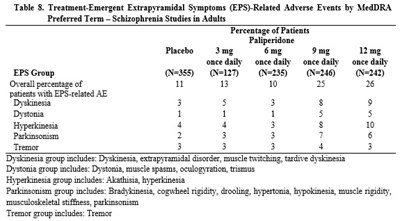
This table provides information on the treatment-emergent extrapyramidal symptoms (EPS)-related adverse events in adults with schizophrenia treated with different doses of paliperidone. The table shows the percentage of patients experiencing EPS-related adverse events such as dyskinesia, dystonia, hyperkinesia, Parkinsonism, and tremor when taking paliperidone at doses of 6mg, 9mg, and 12mg daily. It also includes the specific conditions included in each EPS-related adverse event group.*
9 - Table9

This text provides information on treatment emergent extrapyramidal symptoms (EPS)-related adverse events in adults with Schizoaffective Disorder in relation to the medication Paliperidone and placebo. It includes data on the percentage of patients experiencing different EPS-related adverse events such as Dyskinesia, Dystonia, Hyperkinesia, Parkinsonism, and Tremor. Each group is further detailed with specific symptoms included in the categories.*
* The product label images have been analyzed using a combination of traditional computing and machine learning techniques. It should be noted that the descriptions provided may not be entirely accurate as they are experimental in nature. Use the information in this page at your own discretion and risk.
